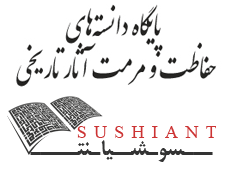Parviz Holakooei، Ferruccio Carlo Petrucci، Renzo Tassinari، Carmela Vaccaro
X- ray Spectroscopy, Vol 42, Issue 2, P.P pages 105–115; 2013
Abstract: An outstanding style of Persian tilework, which emerged from the north-eastern Iran in the 15th century, was extensively used for decorating architectural facades during the Safavid period (from the 16th through the 18th century). This type of tilework, the so-called haft rang, technically comprises of forming a clay body and firing two glazed layers on top of the body. In the present paper, the first analytical data concerning haft rang tiles is provided. To do so, forty three samples of Safavid haft rang bodies were analysed by wavelength dispersive x-ray fluorescence (WDXRF) and the obtained data were handled by principal component analysis (PCA). The results showed that the 17th century haft rang tiles wherever found are local products; that is, Safavid tile-makers have used local clay sources to make the bodies of haft rang tiles. The analytical data also showed that old tileworks, in general sense, can be simply replaced by newly manufactured tiles or, at least, all tilework revetments in an individual edifice might not have been produced in an identical workshop. Moreover, WDXRF was used as an accurate and precise method to determine the chemical composition and to support compositional classification in provenance studies and can be considered as a reliable alternative for studying the provenance of archaeological ceramics.
Application of WDXRF in the provenance studies of Persian haft rang tiles: a statistical approach
X- ray Spectroscopy, Vol 42, Issue 2, P.P pages 105–115; 2013
Abstract: An outstanding style of Persian tilework, which emerged from the north-eastern Iran in the 15th century, was extensively used for decorating architectural facades during the Safavid period (from the 16th through the 18th century). This type of tilework, the so-called haft rang, technically comprises of forming a clay body and firing two glazed layers on top of the body. In the present paper, the first analytical data concerning haft rang tiles is provided. To do so, forty three samples of Safavid haft rang bodies were analysed by wavelength dispersive x-ray fluorescence (WDXRF) and the obtained data were handled by principal component analysis (PCA). The results showed that the 17th century haft rang tiles wherever found are local products; that is, Safavid tile-makers have used local clay sources to make the bodies of haft rang tiles. The analytical data also showed that old tileworks, in general sense, can be simply replaced by newly manufactured tiles or, at least, all tilework revetments in an individual edifice might not have been produced in an identical workshop. Moreover, WDXRF was used as an accurate and precise method to determine the chemical composition and to support compositional classification in provenance studies and can be considered as a reliable alternative for studying the provenance of archaeological ceramics.
See full text on: Wiley Online Library
